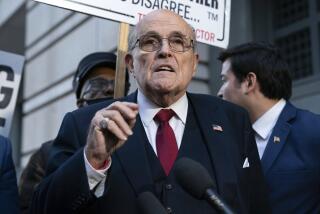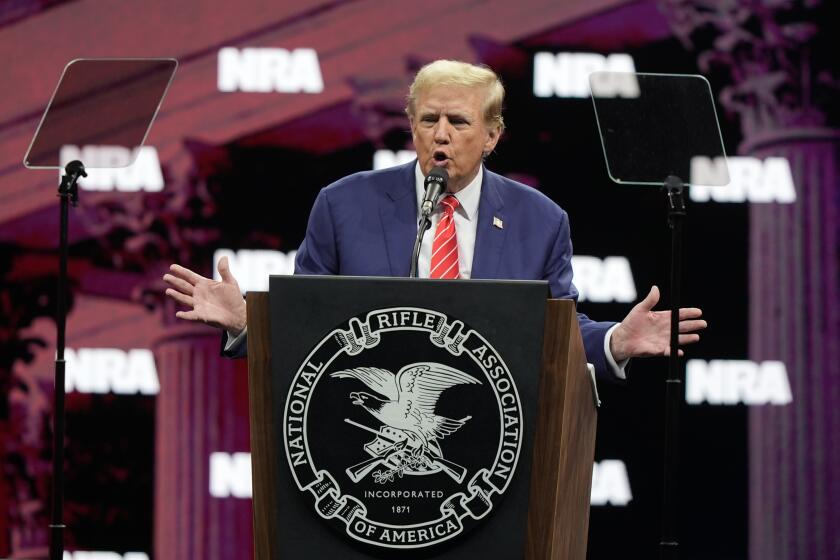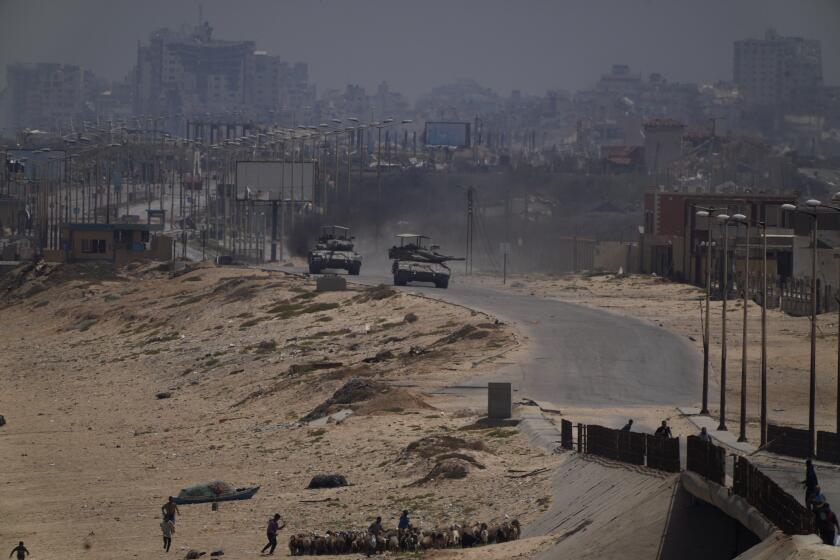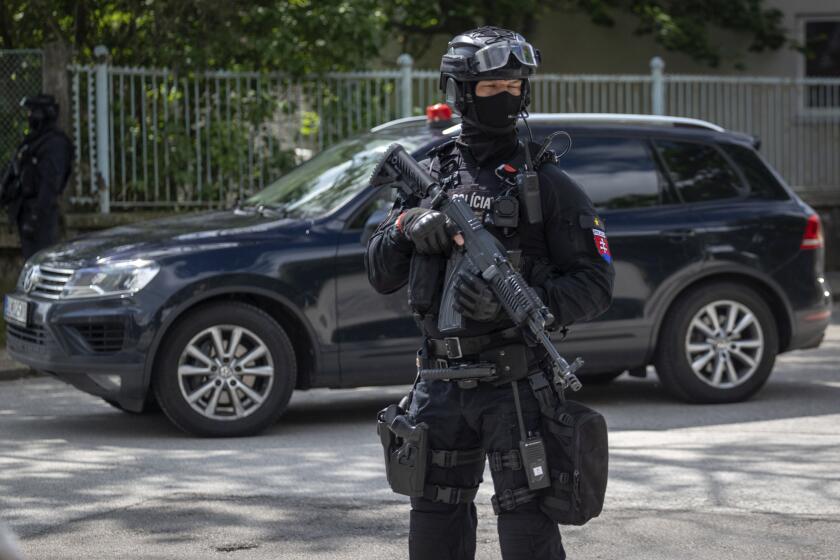COLUMN ONE : Death on the Job--a Lifework : Joseph Kinney lost a brother and gained a mission--an attempt to put faces on the ghosts of those killed at work.
Want to know why so many American workers die needlessly on the job? Ask Joseph Kinney. It’s all he talks about.
First he’ll tell you of his days in the Marine Corps in Vietnam, how his officers were held directly accountable for the men who died under them, how that sensitized them. Then he’ll talk about businessmen.
“The trouble with corporate executives is that they don’t write enough next-of-kin letters,” he says in that flat, accusatory voice. “They don’t go and talk to grieving widows. They don’t go and teach little boys how to throw curve balls. They don’t go and give little girls away at weddings. Maybe if they were more in touch with the damage--just the social damage--we wouldn’t have this big a problem.”
Kinney, the most frequently quoted authority on worker safety in the United States, never planned on becoming a zealot. He was a livestock consultant who worked profitably with cattle. Today he works compulsively with ghosts. Ghosts like Robert Campbell, a carpenter who was crushed when a crane boom line snapped in Idaho. Or Charles Elliot, a rubber worker who was asphyxiated while working in a carbon pit in Kansas. Or Brett Von Herbulis, a construction worker who died in a cave-in while digging a trench in Florida.
The ghosts began coming into Kinney’s life four years ago when his 26-year-old brother, Paul, fell off some weak construction scaffolding in Denver, went into a coma and died. The family said it was God’s will. Kinney wouldn’t buy it. There was a reason here, he thought, and he was going to find it.
What he found was that 10 to 20 Americans die on their jobs every day and that the agency established to protect them, the federal Occupational Safety and Health Administration, had become one of the worst casualties of the Reagan Administration’s war against government regulation. Businesses responsible for accidents were fined paltry sums. Criminal prosecution was almost nonexistent. Proposed regulations were rare and languished in the bureaucracy for years.
Kinney, an intense, plain-faced, potbellied man, looked around for an organization devoted to helping people like him. He couldn’t find one. So in mid-1987, he put his consulting business aside and started the National Safe Workplace Institute. He threw so much cold rage into the institute that he became not merely a persuasive advocate but a hero. Many people who have met Kinney celebrate him as a wounded bulldog who kept pounding his fist against the system until it paid attention to his assault on “the cultural accommodation of workplace death.”
In the last few months alone, two U.S. senators extensively quoted Kinney’s critical studies of OSHA as they introduced bills to encourage prosecution of negligent companies and force the agency to pay more attention to families of accident victims. Congressional staffers called Kinney in search of sympathetic witnesses. OSHA’s new director invited him to address a senior staff meeting. Three national organizations with diverse and sometimes conflicting interests--labor, construction and chemical safety--gave him their annual work-safety awards. And network news programs sought out his opinions on topics ranging from construction hazards to the question of whether an employer should be able to bar women of child-bearing age from certain jobs.
The honors are pouring in because Kinney has taken a subject that is often abstract and personalized it with uncommon righteousness.
From a small Chicago office, his nonprofit, grant-funded institute spins anecdotes and statistics into a flurry of reports asserting that many cases of on-the-job deaths and occupational disease stem from gaps in industrial planning, worker training and government inspection, as well as from an unspoken social philosophy that treats work injury as simply a part of the job.
Kinney has, for example, used international labor statistics to calculate that the United States has a worker death rate three to four times higher than Germany’s and France’s. He has conducted a survey finding that half of the families of dead workers are never shown the OSHA investigative report. He has helped block a major construction contract with his safety research. He has published a paperback book called “Faces” that talks simply but movingly about the personal lives of scores of workers killed in a wide variety of jobs. The title is fitting. Kinney never tells a story without a face.
“Joe is the one person responsible more than anyone else in this country for bringing this issue to the public’s attention,” said Los Angeles County Dist. Atty. Ira Reiner, one of a handful of county prosecutors nationwide to develop programs aimed specifically at prosecuting employer negligence that leads to worker deaths and injuries.
Kinney has critics who claim he takes liberties with statistics, but the purity of his mission--”my moral license”--is unassailable. He does not hesitate to play to it.
“My accountability is to the ghosts,” he says. “My brother, my fellow Marines and all the people I’ve become intimately connected with by learning about the circumstances of their deaths at work. When I get to be a ghost, then I want to get lots of pats on the back. I want my little brother to say, ‘You did good.’ ”
In part, Kinney’s success is a cautionary tale. The fact that he could become a major player in such a short time underscores how relatively little shouting is done on behalf of workplace safety. Had Kinney thrown himself into, say, the environmental movement, he would scarcely have been noticed amid thousands of other voices.
America’s grasp of the problem is surprisingly unsophisticated. Nobody actually counts how many people die on the job. The Bureau of Labor Statistics estimates that about 3,300 die each year, but the National Safety Council’s estimate is almost twice as high. Each year, nearly 3 million American workers in private industry suffer on-the-job injuries resulting in lost or restricted work time. The number of days that an average worker can expect to lose from occupational injury and illness during the year has risen 42% since 1973.
Despite the fact that on-the-job deaths and injuries often touch families more dramatically and immediately than environmental problems, worker safety is a poor relative. While Earth Day enjoyed its 20th birthday last weekend, today marks only the second annual Worker Memorial Day, a comparatively anonymous creation of the AFL-CIO designed to call for better job safety regulation.
This disparity gnaws at Kinney. Why, he demands, does the federal government spend 20 times more on the Environmental Protection Agency than on OSHA? “Why do we have at least six fish and game inspectors in the U.S. for every job safety inspector?”
Kinney’s outrage at needless pain began in Vietnam. The war left a complex edge. It shaped the man who can at one moment savor the intellectual side of life, recalling an old college professor’s lecture about “the present-time orientation of the lower classes,” and then advise two young staffers to focus their energies with these words: “Remember, you’re either moving toward your target or you’re killing your target.”
Kinney went to war because his dad--a schoolteacher--and his grandfather had been in the Army and because two uncles had been in the Marines. Vietnam was a generational obligation. He enlisted in the Marines as soon as he graduated from high school in Wichita, Kan., in 1967. His first letters home praised the war as a defense of America. His last one, sent to the secretary of defense, called it a waste.
He’d been there nearly a year when his infantry platoon was ambushed one night. He was hit in the right leg and chest. He couldn’t breathe. A priest asked if he wanted last rites. He came home. He was lucky he’d been badly wounded, he realized later. The insulation of medical treatment spared him the pain of the immediate transition to civilian life.
He decided to go to college. Even as a kid he’d loved to read, to consume information. He graduated in 1972, then went on for a master’s in public administration. Along the way he met the head of the General Services Administration, who offered him a job in Washington studying agricultural issues. That led to a staff job for Minnesota Sen. Hubert Humphrey and, after Humphrey’s death, other congressional staff work.
By 1984, burned out by Washington, Kinney left to set up his livestock consulting business. He also got married and settled in Chicago, where his wife was working. Tales of maladjusted Vietnam vets were everywhere, but he had made his life whole. “I got together with a couple of guys who were NCOs in my platoon and I could not remember 90% of what they were talking about.”
Then one day in the summer of 1986 the phone rang and somebody told Kinney that his kid brother, whose fourth-grade class used to send Joseph drawings and gifts in Vietnam, was on a life-support system in a Denver hospital. Paul Kinney had been stringing fireworks for an Independence Day celebration. He had fallen about 30 feet when a scaffold, constructed improperly, collapsed under him. As Kinney would later learn, such scaffolding disasters are not unusual.
Kinney knew a lot about government but he didn’t know much about OSHA, which had been created in 1970 but fell into decline in the 1980s as its budget was frozen for six years. He knew how to make phone calls, but felt that he could not penetrate the OSHA bureaucracy. Eventually he found out that the building contractor who employed his brother had been fined only $800 by OSHA. In the midst of his anguish he and his wife had a son. They named him Paul-Claude.
By early 1987 Kinney managed to get a meeting with John Pendergrass, then OSHA’s director. Kinney tells the story dramatically.
“He was absolutely out of touch with the damage this stuff does to our communities,” Kinney said. “As I was leaving I looked at him and--this was spontaneous--I said, ‘I suspect I’ll be spending upwards of 30 hours a week on this issue for the next 10 years.’ ” Pendergrass defends himself by characterizing Kinney as a man too obsessed by his brother’s death to be a credible safety analyst.
Kinney’s institute, financed by a few small grants, was in business by May, 1987. Its reports, written on a tightrope between disciplined scholarship and emotional urgency, poured forth.
One of them, a 60-page memo on a huge Midwest waste-water project where 10 construction workers died over two years, helped persuade OSHA in 1988 to levy its largest fine ever against a contractor and ultimately persuaded a local agency to reject one of the firms involved on a new project, even though the contractor submitted the lowest bid.
Another report charged OSHA with cloaking a “pitifully weak” enforcement program behind highly publicized proposed fines that the agency later settled for a pittance.
Kinney also targeted a rapidly growing steelmaker with a frighteningly high fatality rate. He jumped on Domino’s pizza for accidents allegedly caused by the company’s 30-minute-delivery limit. He rounded up victims to publicize OSHA’s 15-year delay in regulating confined-space work, where fatal exposure to toxic gases can occur within minutes. (OSHA issued a standard on confined-space work last June--six years after a “draft proposal” was issued--but it is not expected to take effect until next year.)
In all of these instances and others, Kinney promoted his work to news reporters with considerably more tenacity and passion--to say nothing of moral license--than either academics or organized labor had previously done. He became a one-man resource center. For example, his 1988 report on the laxity of state and federal prosecution of employers responsible for workplace negligence quickly led to newspaper articles.
Kinney had built his reputation and helped define a problem. But there was little to indicate that much government response would be forthcoming. Then last year President Bush made Elizabeth Dole his labor secretary and Dole appointed a lifelong advocate of work safety, Gerard Scannell, head of OSHA.
Months before he was confirmed by the U.S. Senate, Scannell--an OSHA official in the 1970s who had spent the last 10 years as safety and environmental director at Johnson & Johnson--made two pilgrimages to Kinney’s office. Once confirmed, Scannell invited Kinney to speak at a Miami conference of his 250 senior OSHA managers.
“If someone’s out there hurling grenades at us, I’m going to stop the meeting and invite him in,” said Scannell, who is fond of exhorting business leaders to “look at every accident as if it is a management-system failure.”
“Scannell’s different,” Kinney said. “He was a naval underwater demolitions expert. I think he probably understands responsibility fairly well. I like the direction.”
Kinney and others still regard OSHA as ineffective because of restrictions on its power and budget. But, relatively speaking, the agency has been absolutely frisky in recent months. It has made multimillion-dollar fines almost routine. It has begun developing guidelines to control repetitive-motion injuries, set new standards to crack down on poorly constructed construction trenches and created a separate Office of Construction to monitor the building industry, which accounts for 2,500 deaths a year and has the highest injury and illness rate of all major industries.
Two years ago, an OSHA spokesman reacted to one of Kinney’s reports by saying it was “filled with inaccuracies.” An illustration of how times had changed occurred earlier this month when Scannell came to Chicago to testify at a hearing on a bill that Sen. Paul Simon (D-Ill.) introduced at Kinney’s behest. The bill would require OSHA to let families of accident victims meet with OSHA investigators and to participate in settlement conferences with employers. Instead of opposing the bill, Scannell used his testimony to announce that he had implemented many of Kinney’s proposals by administrative fiat three days earlier.
Now Kinney is getting antsy and talks about moving on. He only pays himself $34,000 from the $250,000 he gets in grants and he’d like a job that would let him spend more time with his son. He talks wistfully about “institutionalizing” his institute, letting the staff and a new director run it. But then, ever the prisoner of the “sniper mentality” he says he brought home from Vietnam, he spots new targets.
“Right now I know outside the chemical industry of only one Fortune 500 company where the safety-health guy is a vice president. I know of only one company that talks about safety and health of employees in its annual report, Dow Chemical. I’d like to see Harvard do case studies on the real costs to businesses in safety and health calamities. I’d like to see the big business schools bring in some of these right-wing ideologues that they canonized in the ‘80s and let’s have a debate on what’s happened to these companies that have been downsized by acquisitions and mergers--what that’s meant to (safety) training programs, risk assessment? Why don’t we have OSHA set a requirement where anybody who wants to buy a company is going to have to talk about these issues? We need to be like the environmentalists, in terms of forcefully advocating these points of view.”
And then he thought of something that bugged him.
“I just read an article to protect the owls in the Northwest. I wonder how many Senate staff people devoted how many years to that? There’s nobody on the U.S. Senate staff who works full time on worker safety year-round. I’d be perfectly happy to go back home to Kansas and box up all the goddamn owls they want and send them out to Washington and Oregon.”
A CAPSULE LOOK AT U.S. WORKER INJURIES
The Bureau of Labor Statistics’ most recent survey, covering 1988, shows that: There were 8.3 injuries for every 100 full-time American workers in private industry.
Injuries rose by 352,000 to 6.2 million, an increase of 6%.
Nearly half of the injuries were serious enough to cause lost work time or restricted activity.
About 60% of the increase in injuries occurred in manufacturing, primarily transportation equipment, fabricated metal products, primary metal industries and non-electrical machinery.
The construction industry remained the most hazardous sector, with more than 650,000 injuries and illnesses reported.
The rate of lost work days was 72.5 days per 100 workers, 8.8% higher than the previous year and 43% above the 1973 rate.
The field with the highest rate of lost work days was mining, more than twice the national average. The lowest fields were finance, insurance and real estate, which experienced less than a quarter of the national average.
Cases of occupational illness rose 26% to 241,000. Nearly half of the illnesses involved “repetitive-motion” illnesses, in fields ranging from meat packing to telephone operations and cashiering, which increased 58% from 1987. Part of the increase is attributed to better record keeping.
More to Read
Start your day right
Sign up for Essential California for news, features and recommendations from the L.A. Times and beyond in your inbox six days a week.
You may occasionally receive promotional content from the Los Angeles Times.






